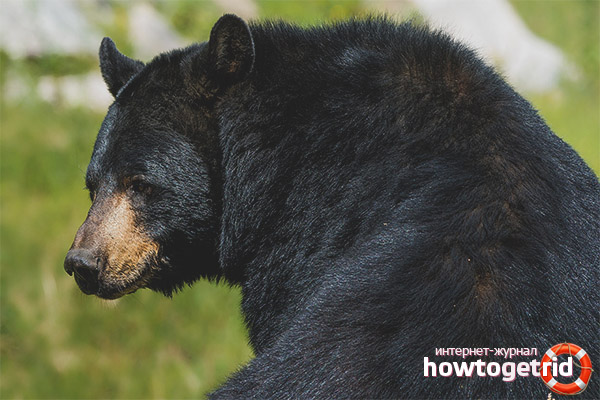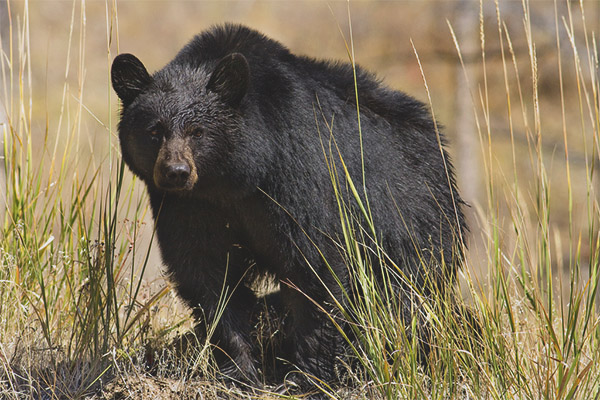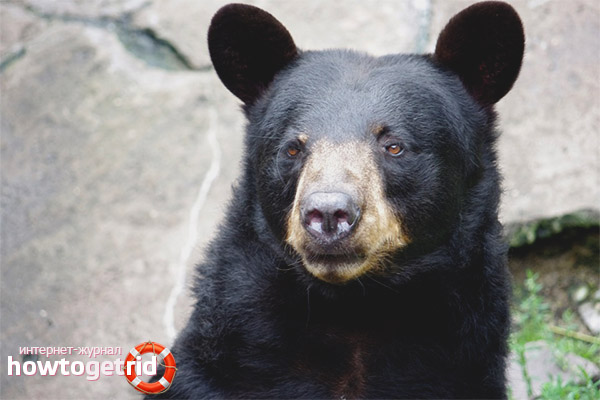The content of the article
A variety of amazing animal world has not bypassed well-known to everyone bears. The hero of the favorite and childish, and the adult audience of fairy tales and cartoons is often remembered in two of his images, correlating with the species existing in reality. So, “Umka” presented knowledge about white bears living in the North; "Masha and the Bear" - about the brown, who have chosen the temperate climate zone. However, the Bear family is not limited to these representatives, which is confirmed by the baribals, otherwise called black bears.
These mammals, like other bears, are predators. There is a disagreement among the classifiers, since some researchers isolate baribals, referring to a separate genus with the Latin name Ea-t tos. Called also North American, black bears are combined into sixteen groups by subspecies.One of these are, for example, ice bears.
What do individuals look like?
The original color in the balibalas is, of course, the color of the fur. That is why, first of all, they differ from brown in black color. The second distinctive feature of the species is size, since baribals are smaller than large-sized brown heroes of Russian folk tales. Adult males grow to two meters in length. The weight of the largest of the identified males was equal to 363 kilograms. The females of the baribs are smaller in size: they are 1.5 meters long and weigh less than 250 kilograms. The average height of a bear is one meter. The tail of animals in size does not exceed 15 centimeters. Completion of the “portrait in growth” of a black bear will be an emphasis on the particular acuity of the shape of the muzzle, as well as on its long limbs and short feet.
As noted above, the color baribal black. The muzzle and chest of the bear are sometimes distinguished by fur, colored with lighter shades. Rare are carriers of fur skins of a different color among the representatives of this species of the Bear family. At the same time, in one litter often bear cubs of both brown and black color are found.
Interesting fact! Some young baribal individuals own a unique gray color, which is subsequently replaced by a darker fur. This happens around the second year of the animal's life.
The baribals of black color with blue shimmer are gifted with truly beautiful fur. They are also called "blue" or "glacial."
What is the lifestyle of a mammal?
Interesting fact! In areas where livelihoods are concentrated, groups of bears may settle. This leads to the emergence of a special hierarchy between neighboring individuals.
The good mental abilities of bears contribute to the curiosity pronounced in individuals. The consequence of this are skills in conducting intelligence. In addition to this, researchers note that adult baribals are well oriented in space.Animal navigation skills are of great interest for more in-depth study.
How long do bears live?

In natural habitat, the life expectancy of baribal is equivalent to three decades. However, in the current situation of a sharp deterioration in the ecological situation and the development of poaching, the life of a black bear lasts about ten years. About nine out of ten individuals die when they are two years old, as a result of fishing, shooting, and the effects of other man-made and anthropogenic factors (traffic accidents).
Where are bears settled?
The main area of distribution of the population of black bears is North America, which gave one of the unofficial names of the species. There, plains and forests became favorable places for the settlement of individuals. By the end of the XIX century, the population of the continent consisted of two million individuals. But later, most of it was destroyed by man. This provoked the departure of representatives of the species of many states and reduced the number of baribals living in the country.
The peculiarity of the baribs is the resettlement of each subspecies in specific areas.For example, the bears of the species Ursu sämérisnus californiensis live on the mountains near California, on the shores of the Pacific Ocean there are Ursu sämérisusalti frontalis, and on the territory of Alaska Ursus American simmons. Today, baribals live and live in areas densely planted with larch trees and located far from human settlements. In the North American continent, baribals coexist with the well-known many grizzlies, which are a variety of brown bears. Most of the rocky areas are occupied last, which is why black bears are rarely found there.
What does a bear eat?
In their behavior, bears are distinguished by the absence of aggression and timidity. Another feature of baribal is their omnivorous. The lack of intelligibility and fastidiousness made the diet of mammals quite diverse. So, they can taste and insects, and berries, and roots. Do not forget that the bear is a predatory animal, but in most cases eating vertebrates does not occur as a result of targeted hunting, but due to the discovery of carrion or carrion.Thus, to the started list of “dishes” it is worth adding delicacies in the form of small animals: birds, rodents, rabbits and even deer.
A baribal individual eats as much as it can accommodate. After finishing the meal, the bear is asleep. Awakened and hungry, he again begins to search for food. Usually the animal gives preference to mountain ash, cranberries, various nuts, blueberries, lingonberries, and, of course, raspberries. The specific content of the plant part of the diet of baribals, constituting from 80 to 90% of all food, varies according to the season, that is, varies from seasonality. In such spring months as April and May, they eat a large amount of grassy plants growing in the forest during this period. By the beginning of summer, the diet is significantly enriched, since it includes insects: caterpillars, ants. Autumn is the most favorite bear time. Forests are full of their favorite delicacy - berries, mushrooms and acorns. Baribals living near the shore of the water bodies also catch fish spawning in the shallow water zone.
At the same time, autumn is one of the most difficult periods for a bear, since it becomes clear in the autumn months,with what “edible luggage” he will go to winter. During this period, the baribal begins to not only saturate, but to store fat. This process is of particular importance for females, as they will fatten the offspring during the winter months. Of course, this critical time is experienced by bears, and they all go into hibernation with good fat reserves, which are helped by various fruits, nuts and acorns enriched with proteins, fats and carbohydrates.
Enemies of baribal
The main enemies of the baribs found in their natural habitat are the grizzly, the puma wolf. Interesting is the following pattern, tracked by scientists. A decrease in the number of the grizzly population in a specific territory is followed by an increase in the number of baribal individuals there. Little bears that become prey to coyotes are at particular risk. Living on the coast of the Mississippi bears fall into the jaws of large-sized alligators.
Interesting fact! According to observations made by zoologists, baribals of a unique light color are more dexterous and successful anglers than black bears.This fact is explained by the ability bestowed on unusual individuals not to contrast with the sky, but to shade it with its color of fur.
Features of procreation
The beginning of summer is marked by the marriage period of baribals. It lasts until mid-July. Females and males are looking for a pair with which they mate. For the first time this happens in individuals that have reached three years of age, which is explained by the ability of females to bear children. Female individuals bear offspring for 7-8 months. As a result, bears are born, the number of which varies from one to three. They are born blind and deaf, the body weight of babies reaches about 300 grams. The first time the cubs open their eyes after four weeks. After that, their growth and development is greatly accelerated. This is caused by mother's milk, which has a large amount of nutrients. Bear milk consumption will continue for six months. However, the courtship of the offspring on the part of the mother does not end there, since the cubs stay with her for up to one and a half years.
The unique ability of baribal cubs is the ability to follow a mother mom after she leaves the winter lair.The ongoing interaction allows the kids to get acquainted with the basic rules of preserving their own lives, as well as the peculiarities of feeding the future offspring. If the cub behaves disobediently, the bear may growl at him or even slap. Excellent nutrition, an active lifestyle contribute to a set of cubs to eight months of weight equal to 7-9 pounds.
What is the status of the type of baribal?
Important, but no less interesting fact! If you meet baribal, you can not pretend to be dead, as is commonly done in the case of brown bears. On the contrary, it is necessary to make a lot of noise in order to scare away a timid animal, thereby preserving both its own and its life.
Since in recent times the population of North American black bears has significantly decreased, protective measures have appeared. Their introduction has allowed an increase in the number of individuals living on the territory of national parks and nature reserves.
Video: Baribal (Ursus americanus)













To send